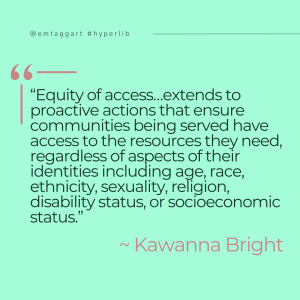Hyperlinking, by definition, is connecting.

By mission and purpose, public libraries in the US provide equitable access to information and services: “Equity of access…extends to proactive actions that ensure communities being served have access to the resources they need, regardless of aspects of their identities including age, race, ethnicity, sexuality, religion, disability status, or socioeconomic status.” (Bright, 2022, p. 67)
For this module, the digital divide remained top-of-mind for me. In many communities, public libraries are the hyperlinks facilitating equitable access to the resources, services, and experiences happening online.
Cultural and informational dialogue happens on and is driven by online platforms. For example, regardless of one’s opinion or use of TikTok, it’s nearly impossible to be a reader in the US and not be influenced by the dialogue happening on #BookTok (see Kelly Jensen’s article from this module’s reading As Seen on #BookTok: Inspiring Young Readers, TikTok Is a Boon for Books). For readers without the economic means to buy unlimited books, the library provides equitable access for folks to read the books AND join the conversation. For folks who want access to credible information on current events but cannot afford a New York Times or Economist subscription, the library can buy subscriptions and provide equitable access to important information.
The information, resources, services, and experiences that can be equitably accessed at the library are not consumables; they are gateways to the conversations and connections necessary for building communities.
Audra Williams and Charlie Muller’s article (Libraries Are Bridging the Digital Divide) on the Internet Society’s blog reports how libraries can (and do) connect communities to high-speed internet. Though California is the fifth largest economy in the world, there are significant wealth and infrastructure gaps across the state. According to a fact sheet developed by the Public Policy Institute of California:
- 85% of California households have high-speed or broadband internet access,
- 8 in 10 low-income and 2 in 3 rural households have broadband access at home. 80% of this population have devices in their home.
As LIS professionals, we can look at this reporting on a deeper level and ask questions such as:
- What about the 15% of California households without high-speed internet access? How many of those 85% can afford access?
- What infrastructure and outreach are needed to connect the 20% of low-income and rural Californians who do not have a device that connects to the Internet to a public library?
While it does not rest on librarians and libraries to solve every issue of equitable access, LIS professionals can initiate conversations and partnerships to take the proactive actions necessary to build community connections.
Libraries are equitable hyperlinks for the information, resources, and shared experiences necessary for healthy communities.
Additional reference not hyperlinked in the text above
Bright, K. (2022). Equity of access, diversity, and inclusion. In S. Hirsh (Ed.). Information services today : An introduction. Rowman & Littlefield Publishers.
@emtaggart You ask some very important questions. I know libraries are circulating wifi hot spots but I am not 100% sure on how fast those can be. The stats you share point toward looking for solutions with partnerships etc that might give access to more of the 15%.